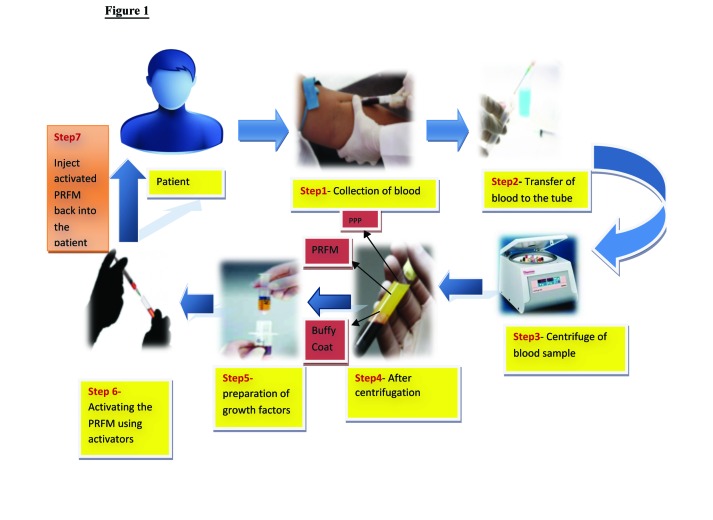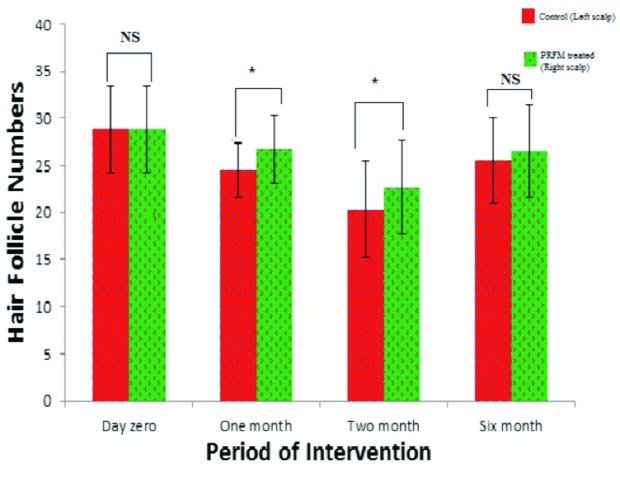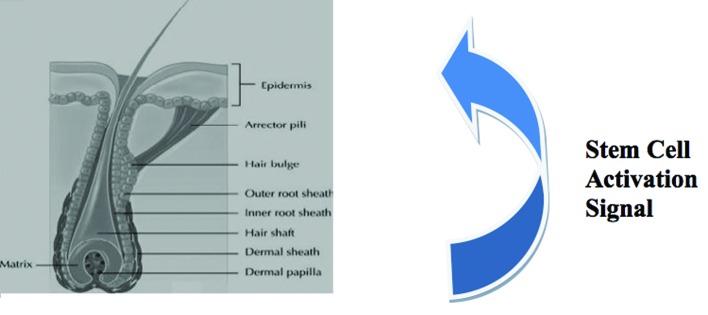Abstract
Objective: Hair loss is a significant problem worldwide. The most common cause of hair loss in men is male androgenetic alopecia, male pattern baldness, which is primarily due to the presence of nonfunctional or dead hair follicles in the scalp. Hair follicular unit transplantation has been a widely used technique to transplant hair follicles into bald areas. Although follicular unit transplantation generally gives satisfactory hair transplantation, efforts have been made to further increase the efficacy of follicular unit transplantation in hair regeneration. The crucial discovery of platelet-derived growth factors has resulted in the development of novel autologous therapeutic methods. Platelet-rich fibrin matrix represents a revolutionary step in the platelet gel therapeutic concept. This technique is fast and involves minimal in vitro manipulations. In this paper, the authors studied the efficacy of platelet-rich fibrin matrix in conjunction with follicular unit transplantation for regeneration of new hair in bald areas in male androgenetic alopecia patients. Design: Ten male subjects between 18 and 50 years of age with Norwood Alopecia from Grade 4 to 6 were chosen for the study. Setting: The study was performed at Derma Solutions clinic, Bengaluru, Karnataka, India. Participants: Patients with thyroid disorders, bleeding disorders, or other co-existing morbidities were excluded. Results: The number of hair follicles began to increase progressively after platelet-rich fibrin matrix treatment was performed on the right side of the scalp and the effect was very distinct after six months of platelet-rich fibrin matrix treatment. Conclusion: This study clearly indicates that platelet-rich fibrin matrix plays a key role in hair regeneration using follicular unit transplantation techniques. Further studies are needed to determine how platelet-rich fibrin matrix helps improve hair retention and regeneration. Additionally, it would be interesting to know how long the effect of platelet-rich fibrin matrix lasts after the termination of therapy. Thus, a future longitudinal study would be very useful. (J ClinAesthetDermatol. 2016;9(9):29-35.)
Hair loss is a significant problem worldwide and can be genetically inherited or caused by multiple factors, including a nutritional deficiency, autoimmune disorder, or an infectious etiology. The most common cause of hair loss in men is male androgenetic alopecia (MAA), male pattern baldness. MAA is the genetically determined loss of the normal thick hair follicle and is associated with progressive hair loss. With MAA, a gradual conversion of terminal hairs into vellus hairs occurs in a highly reproducible pattern that leads to baldness. Studies on hair loss confirm that it is a genetically determined phenomenon.1 Hair transplantation techniques have been widely used to treat baldness. Extracting hair from the safe donor scalp area and implanting the hair follicles to an area with baldness is called hair transplantation. With the follicular unit extraction method, the punch graft technique is employed to extract follicles from one part of the head, which are then are transplanted into tiny holes or slits in bald areas of the scalp.2
Various strategies have been developed to assist hair transplantation in order to increase the efficacy of the method. The crucial discovery of platelet-derived growth factors (PDGF) in promoting wound healing, tissue regeneration, angiogenesis, chemotaxis, cell proliferation, differentiation, immune modulation, remodeling, and antimicrobial activity has resulted the development of novel autologous therapeutic methods.3,4 Importantly, a number of platelet concentrates can be prepared for therapeutic applications.
Various factors identified so far that are released by the platelets on activation are transforming growth factor alpha and beta (TGF-α and TGF-β), epidermal growth factor (EGF), fibroblast growth factor (FGF), keratinocyte growth factor (KGF), insulin growth factor (IGF), platelet-derived epidermal growth factor (PDEGF), interleukin-8 (IL-8), tumor necrosis factor alpha (TNF-a), connective tissue growth factor (CTGR), and granulocyte-macrophage colony stimulating factor (GM-CSF).5-7 These factors have a positive effect on tissue repair. The modes of action of these factors have been discussed elsewhere.8Platelets are easily collected from the bloodstream and are concentrated in a small volume of plasma known as platelet-rich plasma (PRP). Anticoagulants are typically used for this procedure.9 PRP is typically a two-step procedure.10-13 In the first step, the platelet concentrate is separated from the platelet-poor plasma (PPP) and white blood cell and red blood cell fraction. In the second step, the activator, such as calcium gluconate, is added to the platelet concentrate, which results in the formation of a fibrin network by converting the fibrinogen present in the platelet concentrate to fibrin. It is a short term and less effective procedure when compared to platelet-rich fibrin matrix (PRFM).
PRFM represents a new step in the platelet gel therapeutic concept with simplified processing without anticoagulants.14 Unlike other platelet concentrates, PRFM in contrast to PRP, isolates platelets and plasma after the first centrifugation itself. PRFM containing various growth factors has recently been used during follicular unit transplantation (FUT) to increase hair density and stimulate follicular unit growth. PRFM is the extraction of platelets from the patient’s own blood, which is injected back into the patient. Platelet-rich fibrin represents a revolutionary step in the platelet gel therapeutic concept.15 This technique, unlike the other platelet concentrates, involves only the centrifugation of natural blood without any additives. PRFM was developed by Choukroun et al16 in 2001 in France. The success of this technique depends on the speed of collection of the blood and transfer to the centrifuge as no anticoagulant is used.17 A simplified processing technique without complex handling makes it superior to PRP.
In this paper, given the success and simplicity of the PRFM technique, the authors aim to ascertain the efficacy of PRFM in conjunction with hair follicular transplantation technique for the regeneration of new hair in patients in India, as not many studies have been done in India to date.
MATERIALS AND METHODS
Study design. Inclusion criteria. Ten male subjects between 18 and 50 years of age with Norwood alopecia (type of classification of baldness, published in 1975, is the most widely used classification for hair loss in men. Hamilton-Norwood scale is usually employed to classify the progress of MAA, which ranges from grades 1 to 7) from grade 4 to 6 were chosen for the study. The study was performed at Derma Solutions, Marathahalli, Benguluru, Karnataka, India.
Exclusion criteria. Patients with thyroid disorders, bleeding disorders, or other coexisting morbidities were excluded.
Informed consent was obtained from all subjects and PRFM preparations were performed at DiponEd BioIntelligence LLP (Bangalore, Karantaka, India)
Ethics. The study was approved by Institutional Ethics Committee (IEC).
Preparation of PRFM. PRFM was prepared using DiponEd BioIntelligence LLP protocol that was approved by the ethics committee. About 10mL of blood was drawn from each patient in two sterile vacutainer tubes without anticoagulant and then the tubes were placed in a centrifuge at 3,000 revolutions per minute (rpm) for 10 minutes. After centrifugation, three layers were obtained; yellow-colored acellular plasma in the upper layer, red-colored red blood cells (RBCs) in the lower layer, and PDGF in the middle layer. The middle layer containing platelets trapped in fibrin meshes was used for applications in this study (Figure 1)
Figure 1.
A stepwise description of the PRFM procedure, demonstrating the process from the collection of blood to the preparation of PRFM to the injection of PRFM into the patient.
Treatment protocol. The male subjects were treated with intradermal injections of autologous PRFM three times; first at Day 0 prior to FUT, and subsequently in the second and third months. An equal number of follicular units was implanted in a 1x1cm2 area on both the left and right temporal area. Follicular density at a calibrated distance from the mid-pupillary point in a 1x1cm2 (right temporal area) area was measured using digital photographs taken at the one-, two-, and six-month follow-up visits. Hair density indices were compared using Trichoscope with photographs from similar areas (left temporal area) as control on same subjects without PRFM injections.
Statistics. Statistical analyses were made with the student’s t-test. A value of P<0.05 indicated statistical significance.
RESULTS
Combined case studies on the efficacy of PRFM treatment on patients with androgenetic alopecia showed improvement in the hair follicle counts. In order to determine the efficacy of PRFM, the authors provided PRFM treatment for the subjects for a period of six months. Hair follicle counts were performed on 10 patients before and after implantation, with and without (control) PRFM treatment, and an equal number of follicular units were implanted in a 1x1cm2 area both on the left and right temporal areas throughout the entire study unless otherwise mentioned, whereas the PRFM treatment was only carried out in the same implanted 1x1cm2 area on the right temporal area. The post-implantation and PRFM treatment on the right side of the scalp were compared with the control (i.e., the left side of the scalp, not treated with PRFM post-implantation) at each indicated time period (Tables 2–4; Figures 2–4).
TABLE 2.
Terminal hair follicle counts in a 1x1cm2 patch area on both the right and left side (control) of the scalp in 10 patients
| PATIENT | DAY ZERO | ONE MONTH | TWO MONTHS | SIX MONTHS | ||||
|---|---|---|---|---|---|---|---|---|
| LEFT (1cm2) | RIGHT (1cm2) | LEFT (1cm2) | RIGHT (1cm2) | LEFT (1cm2) | RIGHT (1cm2) | LEFT (1cm2) | RIGHT (1cm2) | |
| 1 | 30 | 30 | 24 | 27 | 14 | 17 | 28 | 28 |
| 2 | 25 | 25 | 23 | 23 | 21 | 20 | 22 | 24 |
| 3 | 27 | 27 | 22 | 25 | 12 | 15 | 24 | 25 |
| 4 | 35 | 35 | 30 | 35 | 20 | 20 | 35 | 33 |
| 5 | 28 | 28 | 22 | 25 | 22 | 27 | 25 | 27 |
| 6 | 38 | 38 | 27 | 30 | 28 | 32 | 30 | 36 |
| 7 | 24 | 24 | 25 | 24 | 20 | 23 | 26 | 22 |
| 8 | 29 | 29 | 26 | 28 | 28 | 26 | 21 | 20 |
| 9 | 24 | 24 | 26 | 24 | 18 | 22 | 20 | 23 |
| 10 | 29 | 29 | 20 | 26 | 20 | 25 | 24 | 27 |
The left side of the scalp is the control; post-implantation without PRFM treatment. The right side of the scalp is the post-implantation with PRFM treatment. The terminal follicle count of all 10 patients was monitored for six months and the numerical values are presented in the table.
TABLE 4.
Terminal hair follicle counts in 10 patients in 1x1cm2 patch area on both the right and left side (control) of the scalp, evaluated on Day 0, one month, three months, and six months
| TERMINAL HAIR FOLLICLE | LEFT SCALP (1cm2) | RIGHT SCALP (1cm2) | DIFFERENCE | tVALUE | PVALUE |
|---|---|---|---|---|---|
| Day 0 | 28.90±4.58 | 28.90±4.58 | 0.00 | 0.00 | 1.000 |
| One month | 24.50±2.92 | 26.70±3.59 | 2.20±2.52 | 2.750 | 0.022* |
| Three months | 20.30±5.12 | 22.70±5.03 | 2.40±2.50 | 3.032 | 0.014* |
| Six months | 25.50±4.53 | 26.50±4.93 | 1.00±2.86 | 1.103 | 0.299 |
Terminal hair follicle was evaluated in all 10 patients, on both sides of the scalp; right side (PRFM treated post-implantation) and left side (control: PRFM untreated post-implantation). Difference, student’s t value and the significance was evaluated. The numerical values are presented as Mean ± SD. Note: * Moderately significant (P value:0.01<P ≤ 0.05), ** Strongly significant (P value : P≤0.01).
Figure 2.
Evaluation of terminal hair follicle at Day 0, one month, three months, and six months. Numbers of terminal hair follicles were calculated in all 10 patients, on both sides of the scalp; right side (PRFM treated post-implantation) and left side (control: PRFM untreated post-implantation). X-axis represents the period of intervention and the Y-axis represents the hair follicle numbers. Note: * P<0.05; NS=not significant
Figure 4.
The pictorial description of the hair follicle. Different parts of a hair follicle are described, starting from the epidermis to the dermal papilla for a clear understanding of the physiology of the hair follicle.
At the beginning of this study, the hair follicles were implanted in both the left and right side of the scalp and the numbers were compared between pre- and post-implantation as shown in Table 1. Post-implantation, only the right side of the scalp was treated with PRFM and the left side of the scalp was left untreated.
TABLE 1.
Number of hair follicles implanted in 10 patients in a 1x1cm2 patch area on both the right and left side (control) of the scalp
| PATIENTS | LEFT (BEFORE IMPLANTATION) (1cm2) | LEFT (AFTER IMPLANTATION) (1cm2) | RIGHT (BEFORE IMPLANTATION) (1cm2) | RIGHT (AFTER IMPLANTATION) (1cm2) |
|---|---|---|---|---|
| 1 | 2 | 30 | 0 | 30 |
| 2 | 0 | 25 | 2 | 25 |
| 3 | 3 | 27 | 5 | 27 |
| 4 | 4 | 35 | 6 | 35 |
| 5 | 3 | 28 | 1 | 28 |
| 6 | 5 | 38 | 8 | 38 |
| 7 | 3 | 24 | 2 | 24 |
| 8 | 4 | 29 | 6 | 29 |
| 9 | 6 | 24 | 7 | 24 |
| 10 | 5 | 29 | 4 | 29 |
The hair follicles were implanted in all 10 patients and the numbers are presented in the table.
As shown in Table 2, the number of transplanted hair follicles had better retention of follicles post-implantation on the right side of the scalp treated with PRFM when compared to the left side of the scalp that was not treated with PRFM post-implantation. Thus, the PRFM treatment exhibited a beneficial role in retaining the hair follicle at the implanted area.
Next, the authors calculated the difference in the hair follicle numbers on both the right and left side of the scalp. Clear statistical difference and significance values were obtained after one month (25.60±3.38, P<0.001**), two months (21.50±5.09, 0.002**), and six months (26.00±4.63, P=0.005**). Numerical values are displayed in Table 3.
TABLE 3.
Terminal hair follicle counts in 10 patients in a 1x1cm2 patch area on both the right and left side (control) of the scalp, evaluated on Day 0, one month, three months, and six months
| TERMINAL FOLLICLE | MIN-MAX | MEAN±SD |
|---|---|---|
| Day 0 | 24.00-38.00 | 28.90±4.46 |
| One month | 20.00-35.00 | 25.60±3.38 |
| Two months | 12.00-32.00 | 21.50±5.09 |
| Six months | 20.00-36.00 | 26.00±4.63 |
| SIGNIFICANCE | ||
| Day 0-one month | d=3.300;t=4.296;P<0.001*** | |
| Day 0-three months | d=7.400;t=6.285;P<0.001*** | |
| Day 0-six months | d=2.900;t=4.714;P<0.001*** | |
Terminal hair follicle was evaluated in all the ten patients on both left (control) and right side of the scalp (PRFM treated post-implantation). Difference, student’s t value and the significance was evaluated. The numerical values are presented as Mean ± SD
Having established that PRFM treatment showed beneficial effect on hair follicle numbers, the authors investigated the difference in the hair follicle numbers post-implantation and PRFM treatment both on the left and right side of the scalp. The results on the right side of the scalp (treated with PRFM) were compared to that of the left side of the scalp (control, not treated with PRFM). As shown in Table 4, at Day 0, hair follicle numbers on the right scalp (28.90±4.58) had reduced to (26.70±3.59) in one month and after six months the difference in the hair follicle numbers stayed about the same (26.50±4.93). In comparison, however, the hair follicle numbers on the left scalp went down as well; at Day 0 post-implantation, 28.90±4.58 reduced to 24.50±2.92 after one month, 28.90±4.58 reduced to 20.30±5.12 after two months. After six months of post-implantation without PRFM treatment, the difference became 25.50±4.53. The graphical representation of the data is presented in Figure 2.
Finally, the authors examined the effect of PRFM on hair retention after FUT. The effect was monitored from Day 0 to six months (Figure 3). As shown in Figure 3, the authors clearly observed improvement in hair retention after PRFM treatment post-implantation on the right side of the scalp as compared to the left side of the scalp (control) that was not treated with PRFM.
Figure 3.
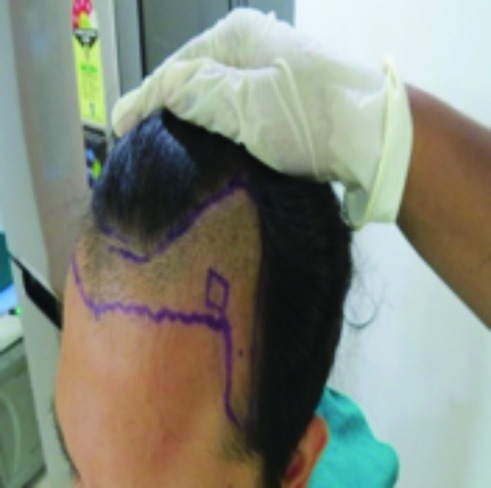
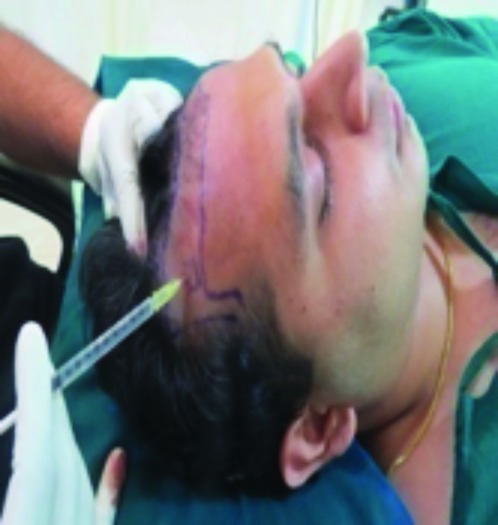
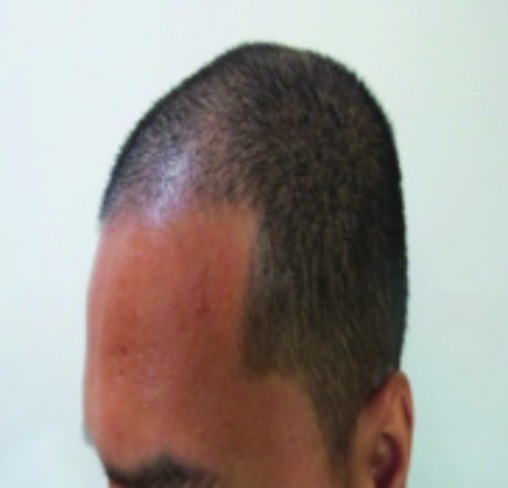
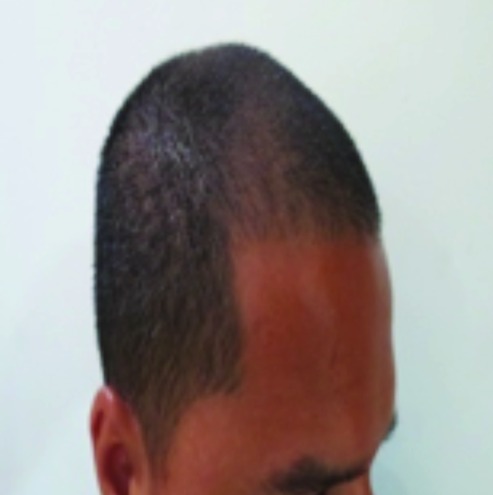
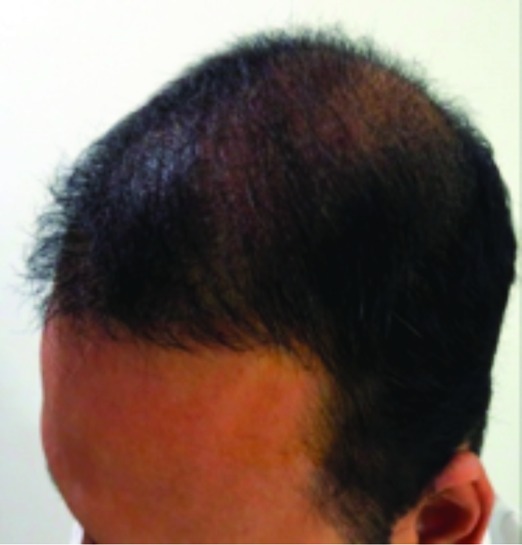

(A) Photographs showing the PRFM treatment being performed on the right side post-implantation and also the left side post-implantation. (B) Photographs taken after two months post-implantation and PRFM treatment. Right side of the scalp is PRFM treated post-implantation and left side of the scalp is the control: PRFM untreated post-implantation. (C) Photographs taken after six months post-implantation and PRFM treatment. Right side of the scalp is PRFM treated post-implantation and left side of the scalp is the control: PRFM untreated post-implantation.
DISCUSSION
Androgenetic alopecia (AA) is a genetically determined phenomenon that is defined by gradual loss and reduction of normal thick hair follicles. AA affects up to 30 percent of men over the age of 30 and 50 percent of men over the age of 50 and affects women as well.18
Several methods have been developed for the promotion of hair growth. Minoxidil, finesteride, and 655nm laser treatment have all been approved by the United States Food and Drug Administration (FDA).19,20
Since etiologies of hair loss are so diverse, it is necessary to have a clear understanding of the physiology of hair follicles. Stem cells are present in the bulge of the hair follicle at the outer root sheath below the insertion of the arrector pili muscle, which connects with dermal papilla and separates into matrix keratinocytes. These cells then go downward and during early anagen,21,22 the papilla is pushed downward. The activity of the bulge stem cells is reduced as the dermal papilla moves downward into subcutaneous fat (Figure 5). The bulge stem cells activity is reduced as these cells become quiescent. Matrix cells differentiate into cells of cortex, medulla, and cuticle and this directs the hair growth. The replicative capacity of the transient amplifying cells of the matrix is limited; as a result, the cells will eventually undergo terminal differentiation. The anagen phase is generally 2 to 5 years while the catagen phase is only a few days to a few weeks.23 The dermal papilla reverts into the dermis during this phase, finally resting close to the bulge at the beginning of telogen. After the telogen phase, which lasts for about three months, and the exogen phase (shedding of hair), bulge cell proliferation is brought by the anagen, which then migrates to the base of the hair follicle.24 The length of the anagen and the hair including its thickness is shortened in the anagen. A greater number of lymphocytes and mast cells are seen surrounding the reduced hair follicle especially in the bulge region. There is a noticeable reduction in the transient amplifying cells, which is derived from the bulge stem cells. However there is no change in the number of bulge stem cells suggesting the presence of a blocked pathway, which is due to the lack of a stimulator or the presence of an inhibitor. The signals that stimulate the signals to the bulge cells may include PDGF Wnt-7a (wingless, derived from Drosophila melanogaster),25 vascular endothelial growth factor (VEGF), fibroblast growth factor (FGF), keratinocyte growth factor (KGF), and follistatin.26
Attempts have been made to modify the hair follicle microenvironment by activating the platelets to release the factors. PRP is a method to introduce various growth factors, such as PDGF, transforming growth factor beta (TGF-β), and insulin-like growth factor 1 (IGF-1). However, anticoagulants are typically used for this technique. PRFM is a new breakthrough in hair growth. During the PRFM preparation process, a gel-like matrix is created,28 which contains high concentrations of nonactivated, functional, intact platelets present within a fibrin matrix that constantly releases growth factors over a long period of time. In PRFM, the fibrin matrix is well-organized, and it efficiently directs the stem cell migration to the site of injury. Results obtained from in vitro studies has led to advances in clinical application of PRFM. Dohan et al27 observed better healing properties and slower release of growth factors when compared to PRP. This study was designed to evaluate the efficacy of PRFM on FUT.
In this study, the authors observed a beneficial effect of PRFM treatment on the retention of hair follicles after FUT in most of the patients enrolled. Although there was no immediate effect of PRFM treatment on hair follicle numbers and hair regeneration, the authors clearly observed a distinct effect of PRFM treatment in retaining the transplanted hair follicles after a longer duration of treatment (i.e,. six months). It is possible that a PRFM treatment beyond six months might lead to better results in terms of hair follicle numbers and subsequent hair regeneration. Although the effect on the regeneration of hair follicles examined in this study is modest, we clearly observed a statistically significant difference before and after implantation when compared to the control (i.e., left side of the scalp not treated with PRFM post-implantation). PRFM treatment may require about at least six months to take effect, hence the authors did not see pronounced effect during the initial phase of the treatment, as observed in this study. They also presume that after a longer duration of PRFM treatment, the hair regeneration will be visible with greater statistical significance.
CONCLUSION
The authors’ study clearly indicated the key role of PRFM in transplanted hair follicle retention and the possibility of hair regeneration using FUT techniques. Although a clear mechanism has not been determined in this study, the authors presume that PRFM may stimulate dermal angiogenesis and wound healing, which helps improve survival of the transplanted graft and regeneration. Further studies are needed to determine how PRFM helps improve hair retention and regeneration. Additionally, it would be interesting to know how long the effect of PRFM lasts after the termination of therapy. Thus, a future longitudinal study would be very useful.
Footnotes
DISCLOSURE:Kaushik D. Deb is a stockholder and founder/CEO of DiponEd Biointelligence LLP. Derma Solutions is DiponEd Biointelligence’s collaborating partner in this publication. PRFM efficacy is shown for the first time by DiponEd Biointelligence as part of a joint collaboration to develop new therapy to further improve hair transplant procedures and both companies intend to share profit.
REFERENCES
- 1.Uebel CO, da Silva JB Cantarelli D, Martins P. The role of platelet plasma growth factors in male pattern baldness surgery. Plast Reconstr Surg. 2006;118:1458–1466. doi: 10.1097/01.prs.0000239560.29172.33. [DOI] [PubMed] [Google Scholar]
- 2.Boudjema P. A new hair graft implanter: the implanter pen. Hair Transplant Forum Int. 1998;8:1–4. [Google Scholar]
- 3.Frechette JP, Martineau I, Gagnon G. Platelet-rich plasmas: growth factor content and roles in wound healing. J Dent Res. 2005;84:434–439. doi: 10.1177/154405910508400507. [DOI] [PubMed] [Google Scholar]
- 4.Anitua E, Andia I, Ardanza B, et al. Autologous platelets as a source of proteins for healing and tissue regeneration. Thromb Haemost. 2004;91:4–15. doi: 10.1160/TH03-07-0440. [DOI] [PubMed] [Google Scholar]
- 5.Borzini P, Mazzucco L. Tissue regeneration and in loco administration of platelet derivatives: clinical outcome, heterogeneous products, and heterogeneity of the effector mechanisms. Transfusion. 2005;45:1759–1767. doi: 10.1111/j.1537-2995.2005.00600.x. [DOI] [PubMed] [Google Scholar]
- 6.Westerhuis RJ, van Bezooijen RL, Kloen P. Use of bone morphogenetic proteins in traumatology. Injury. 2005;36:1405–1412. doi: 10.1016/j.injury.2005.02.047. [DOI] [PubMed] [Google Scholar]
- 7.Everts PA, Knape JT, Weibrich G, et al. Platelet-rich plasma and platelet gel: a review. J Extra Corpor Technol. 2006;38:174–187. [PMC free article] [PubMed] [Google Scholar]
- 8.Roman P, Bolta Z. Use of platelet growth factors in treating wounds and soft tissue injuries, platelet growth factors in treating wounds. Acta Dermatoven APA. 2007;16(4) [PubMed] [Google Scholar]
- 9.Marx RE. Platelet -rich plasma (PRP): what is PRP and what is not PRP? Implant Dent. 2001;10:225–228. doi: 10.1097/00008505-200110000-00002. [DOI] [PubMed] [Google Scholar]
- 10.Marx RE, Carlson ER, Eichstaedt RM, Schimmele SR, Strauss JE, Georgeff KR. Platelet-rich plasma: Growth factor enhancement for bone grafts. Oral Surg Oral Med Oral Pathol Oral Radiol Endod. 1998;85:638–646. doi: 10.1016/s1079-2104(98)90029-4. [DOI] [PubMed] [Google Scholar]
- 11.Sanchez M, Anitua E, Azofra J, et al. Comparison of surgically repaired Achilles tendon tears using platelet-rich fibrin matrices. Am J Sports. 2007;35:245–251. doi: 10.1177/0363546506294078. [DOI] [PubMed] [Google Scholar]
- 12.Okada M, Blomback B. Calcium and fibrin gel structure. Thromb Res. 1983;29:269–280. doi: 10.1016/0049-3848(83)90039-7. [DOI] [PubMed] [Google Scholar]
- 13.Fennis JP, Stoelinga PJ, Jansen JA. Mandibular reconstruction: a histological and histomorphometric study on the use of autogenous scaffolds, particulate corticocancellous bone grafts and platelet rich plasma in goats. Int J Oral Maxillofac Surg. 2004;33:48–55. doi: 10.1054/ijom.2003.0452. [DOI] [PubMed] [Google Scholar]
- 14.Sclafani AP. Applications of platelet-rich fibrin matrix in facial plastic surgery. Arch Facial Plast Surg. 2009;25:270–276. doi: 10.1055/s-0029-1242033. [DOI] [PubMed] [Google Scholar]
- 15.Sclafani AP. Safety, efficacy and utility of platelet-rich fibrin matrix in facial plastic surgery. Arch Facial Plast Surg. 2011;13:247–251. doi: 10.1001/archfacial.2011.3. [DOI] [PubMed] [Google Scholar]
- 16.Choi JC, Kim JC. The Choi hair transplanter. In: Stough DB, Haber R, eds. Hair Replacement Surgical and Medical. 1996:125–127. Philadelphia: Mosby. [Google Scholar]
- 17.Roy S, Driggs J, Elgharably H, et al. Platelet-rich fibrin matrix improves wound angiogenesis via inducing endothelial cell proliferation. Wound Repair Regen. 2011;19:753–766. doi: 10.1111/j.1524-475X.2011.00740.x. [DOI] [PMC free article] [PubMed] [Google Scholar]
- 18.Semalty M, Semalty A, Joshi GP, Rawat MSM. Hair growth and rejuvenation: an overview. J Dermatolog Treat. 2011;22:123–132. doi: 10.3109/09546630903578574. [DOI] [PubMed] [Google Scholar]
- 19.International Society of Hair Restoration Surgery. International Society of Hair Restoration Surgery: 2011 Practice Census Results. [Accessed October 27, 2013]; http://www.ishrs.org/sites/default/ files/users/user3/FinalPracticeCensusReport7_1.pdf [Google Scholar]
- 20.Garza LA, Liu Y, Yang Z, et al. Prostaglandin D2 inhibits hair 25. growth and is elevated in bald scalp of men with androgenetic alopecia. Sci Transl Med. 2012;4:26–34. doi: 10.1126/scitranslmed.3003122. [DOI] [PMC free article] [PubMed] [Google Scholar]
- 21.Sun T-T, Cotsarelis G, Lavker RM. Hair follicular stem cells: 26. the bulge-activation hypothesis. J Invest Dermatol. 1991;96:77S–78S. doi: 10.1111/1523-1747.ep12471959. [DOI] [PubMed] [Google Scholar]
- 22.Lavker RM, Miller S, Wilson C, et al. Hair follicle stem cells: their location, role in hair cycle, and involvement in skin tumor formation. J Invest Dermatol. 1993;101(1 Suppl):16S–26S. doi: 10.1111/1523-1747.ep12362556. [DOI] [PubMed] [Google Scholar]
- 23.Yang CC, Cotsarelis G. Review of hair follicle dermal cells. J Dermatol Sci. 2010;57:2–11. doi: 10.1016/j.jdermsci.2009.11.005. [DOI] [PMC free article] [PubMed] [Google Scholar]
- 24.Akiyama M, Smith LT, Holbrook KA. Growth factor and growth factor receptor localization in the hair follicle bulge and associated tissue in human fetus. J Invest Dermatol. 1996;106:391–396. doi: 10.1111/1523-1747.ep12343381. [DOI] [PubMed] [Google Scholar]
- 25.Festa E, Fretz J, Berry R, et al. Adipocyte lineage cells contribute to the skin stem cell niche to drive hair cycling. Cell. 2011;146:761–771. doi: 10.1016/j.cell.2011.07.019. [DOI] [PMC free article] [PubMed] [Google Scholar]
- 26.Zimber MP, Ziering C, Zeigler F, et al. Hair regrowth following a Wnt- and follistatin containing treatment: safety and efficacy in a first-in-man phase 1 clinical trial. J Drugs Dermatol. 2011;10:1308–1312. [PubMed] [Google Scholar]
- 27.Dohan DM, Choukroun J, Diss A, et al. Platelet-rich fibrin (PRF): a second-generation platelet concentrate. Part II: platelet-related biologic features. Oral Surg Oral Med Oral Pathol Oral Radiol Endod. 2006;101:45–50. doi: 10.1016/j.tripleo.2005.07.009. [DOI] [PubMed] [Google Scholar]



